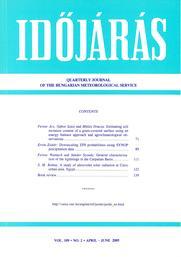Időjárás - Quarterly Journal of the Hungarian Meteorological Service (OMSZ)
Vol. 109, No. 2 * Pages 71–142 * April - June 2005
 |
|
 download [pdf: 29175 KB]
download [pdf: 29175 KB]
Estimating soil moisture content of a grass-covered surface using an energy balance approach and agroclimatological observations
Ács Ferenc, Szász Gábor, Drucza Miklós
idojaras.2005.2.1 (p. 71–)
Ács Ferenc, Szász Gábor, Drucza Miklós
idojaras.2005.2.1 (p. 71–)
Downscaling EPS probabilities using SYNOP precipitation data
Zsótér Ervin
idojaras.2005.2.2 (p. 89–)
Zsótér Ervin
idojaras.2005.2.2 (p. 89–)
General characterization of the lightnings in the Carpathian Basin
Wantuch Ferenc, Szonda Sándor
idojaras.2005.2.3 (p. 111–)
Wantuch Ferenc, Szonda Sándor
idojaras.2005.2.3 (p. 111–)
A study of ultraviolet solar radiation at Cairo urban area, Egypt
Robaa, S. M.
idojaras.2005.2.4 (p. 123–)
Robaa, S. M.
idojaras.2005.2.4 (p. 123–)
IDŐJÁRÁS - Quarterly Journal

Az IDŐJÁRÁS a HungaroMet Nonprofit Zrt. negyedévenként megjelenő angol nyelvű folyóirata
Megrendelhető a journal.idojaras@met.hu címen.
A szerzőknek szánt útmutató itt olvasható.
Megrendelhető a journal.idojaras@met.hu címen.
A szerzőknek szánt útmutató itt olvasható.









